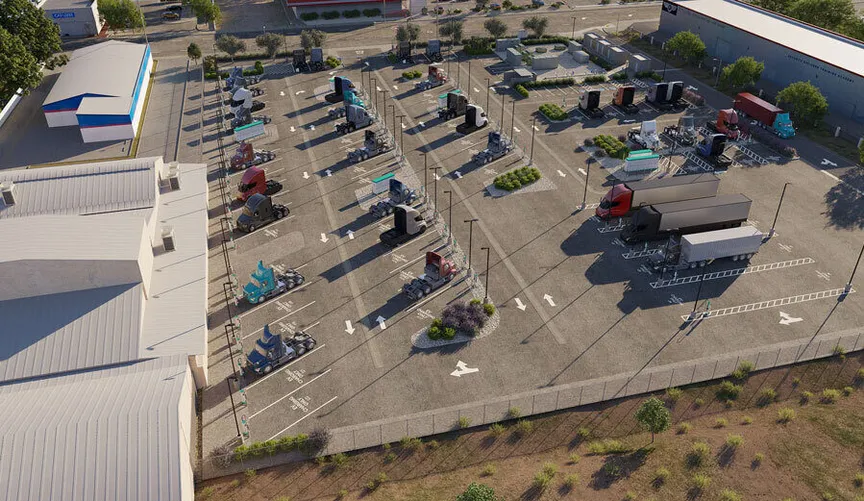The startup has four mega-charging sites planned in the state, and says the underlying economics of electric freight hauling can withstand federal policy reversals.

Electric trucks can beat diesel-fueled ones on the cost of moving freight from California’s seaports to its inland distribution hubs — as long as the battery-powered vehicles can reliably recharge at both ends of their route. That fact is spurring a boom in the construction of truck-charging depots across the state.
On Thursday, EV Realty, a San Francisco-based charging site developer, broke ground on what will be one of California’s biggest fully grid-powered, fast-charging depots for electric trucks so far.
The company’s site in San Bernardino, located in a region known as the Inland Empire that’s crowded with distribution warehouses, will pull about 10 megawatts of power from the grid once it’s up and running in early 2026. It will be equipped with 76 direct-current fast-charging ports, including a number of ultra-high-capacity chargers capable of refilling a Tesla Semi truck in 30 minutes or less.
EV Realty has more large-scale depots in the works, including another in San Bernardino, one in Torrance near the Port of Long Beach, and a fourth in Livermore in Northern California. Thursday’s groundbreaking was accompanied by the announcement that the company had raised $75 million from private equity investor NGP, which also led a $28 million investment in 2022.
With that cash infusion, along with last year’s debut of a joint venture with GreenPoint Partners to develop $200 million in charging hubs, “we are fully capitalized against an underwritten, five-year business plan,” EV Realty CEO Patrick Sullivan told Canary Media.
That plan includes “five to seven more projects of the scale we have in San Bernardino, plus some smaller, more built-to-suit projects,” he said.
EV Realty does build and operate sites for passenger vehicles, such as the chargers it installed in a parking garage in Oakland, California, backed by power provider Ava Community Energy. But the company isn’t in the business of setting up open public charging sites that depend on drive-by traffic to earn money back, Sullivan said.
Instead, it’s signing deals with major freight carriers and fleet owners that want a dedicated spot to get their trucks charged and back on the road as quickly as possible.
That’s why EV Realty’s 76 chargers at its San Bernardino site are all dedicated to specific customers, he said. Of those, 72 are committed to those paying monthly rates on multiyear contracts. “Our customers will have stalls and amounts of power that are theirs 24/7, and we will have customers basing their operations out of that site,” he said.
The remaining four chargers, including those offering high-voltage megawatt charging systems, are “pull-through” slots where trucks towing trailers can get a quick recharge. “That pricing will be more of a pay-as-you-go, per kilowatt-hour — but all those trucks are registered at our site,” he said.
EV Realty is far from the only business building megawatt-scale truck-charging sites in California. Big EV truck depots are springing up around Southern California’s massive port complexes and along its major freight corridors, built by startups such as Terawatt Infrastructure, Forum Mobility, Voltera, WattEV, and Zeem; freight haulers like NFI Industries and Schneider National; and logistics operators such as Prologis.
Most of these depots are providing dedicated service to customers under contracts, but a few are starting to offer charging on a first-come, first-served basis. Greenlane, a joint venture of Daimler Truck North America, utility NextEra Energy, and investment firm BlackRock Alternatives, opened a 10-megawatt truck-charging site in Colton, a city neighboring San Bernardino, that’s meant to provide a more traditional “truck stop” service to vehicles needing to charge.
If anything, EV Realty has been “a little bit more slow and purposeful than others” in building its charging hubs, Sullivan said. But he insists that the broader truck-electrification project remains economically viable, despite the challenges erected by the Trump administration and Republicans in Congress.
There’s no doubt that electric trucking is experiencing a tough moment in California and across the country. The megalaw passed by Republicans in July cut short tax credits for commercial EVs and EV chargers that had been put in place by the 2022 Inflation Reduction Act. This has weakened support for purchasing battery-powered vehicles, which still cost two to three times more than their fossil-fueled counterparts, even if EVs’ lower fueling and maintenance costs can make them cheaper in the long run.
This summer, Republicans and the Trump administration also revoked Clean Air Act provisions that permitted California and 10 other states to set mandates forcing manufacturers to sell increasing numbers of zero-emissions trucks. Last month, major truck manufacturers sued California, seeking to extricate themselves from a clean-vehicle partnership agreement.
Meanwhile, the Trump administration’s trade policies have thrown “sand into the works” of the U.S. freight industry, Sullivan said. Imports are set to decline significantly under President Donald Trump’s tariffs on foreign-made goods, and the on-again, off-again nature of his taxes has scrambled long-term planning.
“Carriers, trucking, transportation companies are at the very front lines of a global trade war,” Sullivan said. “You have no predictability on how you can utilize your assets.”
In the face of that uncertainty, cementing charging for electric trucks along established routes becomes more important than ever, he said. Like many of its charging depot competitors, EV Realty is inking partnerships with other parties in the broader freight-hauling industry, such as its August agreement with Prologis to share and streamline access and software systems across both companies’ networks.
With dedicated charging in hand, freight companies and their customers can start to realize the underlying competitive economics of electric trucks, Sullivan said. “A carrier bidding on freight on a lane is bidding whatever their marginal operating cost is, above or below the cost of fuel,” he said. “If you can move short and regional haul, point to point, with an EV, you’re bidding on a marginal cost that’s lower than diesel.”

